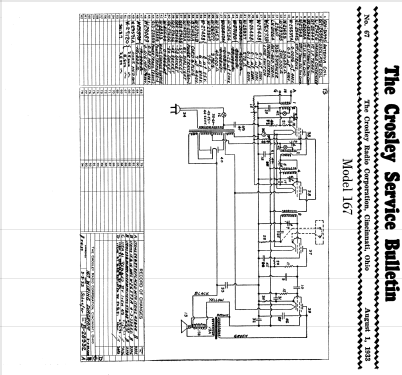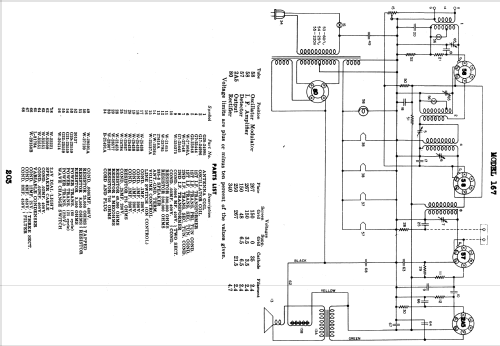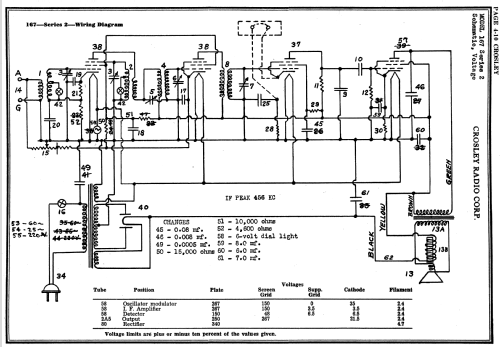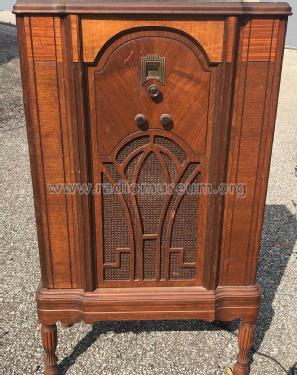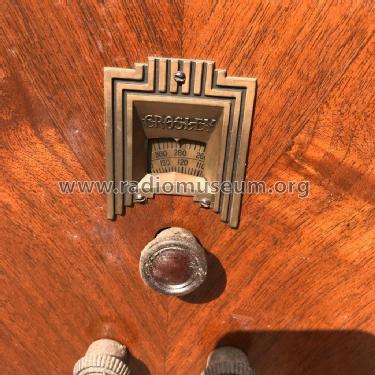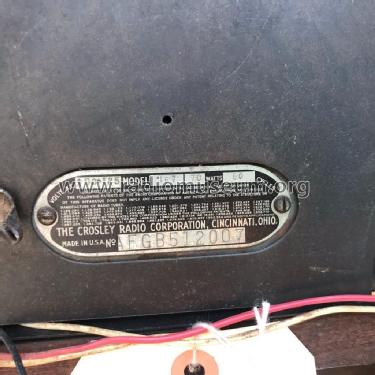Dual Fiver Lowboy Ch= 167 Standard Console - Late Production
Crosley Radio Corp.; Cincinnati (OH)
- País
- Estados Unidos
- Fabricante / Marca
- Crosley Radio Corp.; Cincinnati (OH)
- Año
- 1933/1934
- Categoría
- Radio - o Sintonizador pasado WW2
- Radiomuseum.org ID
- 261312
Haga clic en la miniatura esquemática para solicitarlo como documento gratuito.
- Numero de valvulas
- 5
- Principio principal
- Superheterodino en general; ZF/IF 456 kHz; 2 Etapas de AF
- Número de circuitos sintonía
- 5 Circuíto(s) AM
- Gama de ondas
- OM y banda pesquera/policia USA (75-200m)
- Tensión de funcionamiento
- Red: Corriente alterna (CA, Inglés = AC) / Either transformer: 60 cycles, 110V or 25-60 cycles, 110V or 50-60 cycles, 220 Volt
- Altavoz
- Altavoz electrodinámico (bobina de campo)
- Material
- Madera
- de Radiomuseum.org
- Modelo: Dual Fiver Lowboy Ch= 167 [Standard Console - Late Production] - Crosley Radio Corp.;
- Forma
- Consola baja, patas más cortas del 50%.
- Ancho, altura, profundidad
- 23 x 40.125 x 11.125 inch / 584 x 1019 x 283 mm
- Anotaciones
-
The Crosley Dual Fiver Lowboy is an AC operated 5 tube BC and Police band receiver. This model is the late production model (Crosley calls the late production version "Series 2") and uses the 2A5 output tube along with other passive component differences. The component differences are noted in the Riders schematics (Page 4-10).
Model Output Tube Crosley Service Bulletin Dual Fiver (Early Production) 42 No. 67 Dual Fiver (Late Production) 2A5 No. 72 NOTE: The Schematics show the tube socket numbers, not the tube types!
The picture from the Stein Pre-War Consoles book show only 2 knobs, however the 167 chassis has 3 knobs. Pictures of this model from the Crosley Broadcaster show the proper 3 knobs.
- Precio durante el primer año
- 38.00 $
- Procedencia de los datos
- Pre-War Consoles
- Mencionado en
- - - Manufacturers Literature (Crosley Broadcaster 12, Nov. 15 1933)
- Documentación / Esquemas (1)
- Rider's Perpetual, Volume 4 = ca. 1934 and before (Riders 4-9, 4-10)
- Documentación / Esquemas (2)
- - - Manufacturers Literature (Crosley Service Bulletin No. 72)
- Documentación / Esquemas (3)
- Crosley Radio Service Manual: 1943 Sets and Earlier (Page 203)
- Documentación / Esquemas (4)
- Beitman Radio Diagrams, Vol. 01, 1926-1938 (Page 40)
- Autor
- Modelo creado por John Kusching. Ver en "Modificar Ficha" los participantes posteriores.
- Otros modelos
-
Donde encontrará 1829 modelos, 1054 con imágenes y 1323 con esquemas.
Ir al listado general de Crosley Radio Corp.; Cincinnati (OH)


